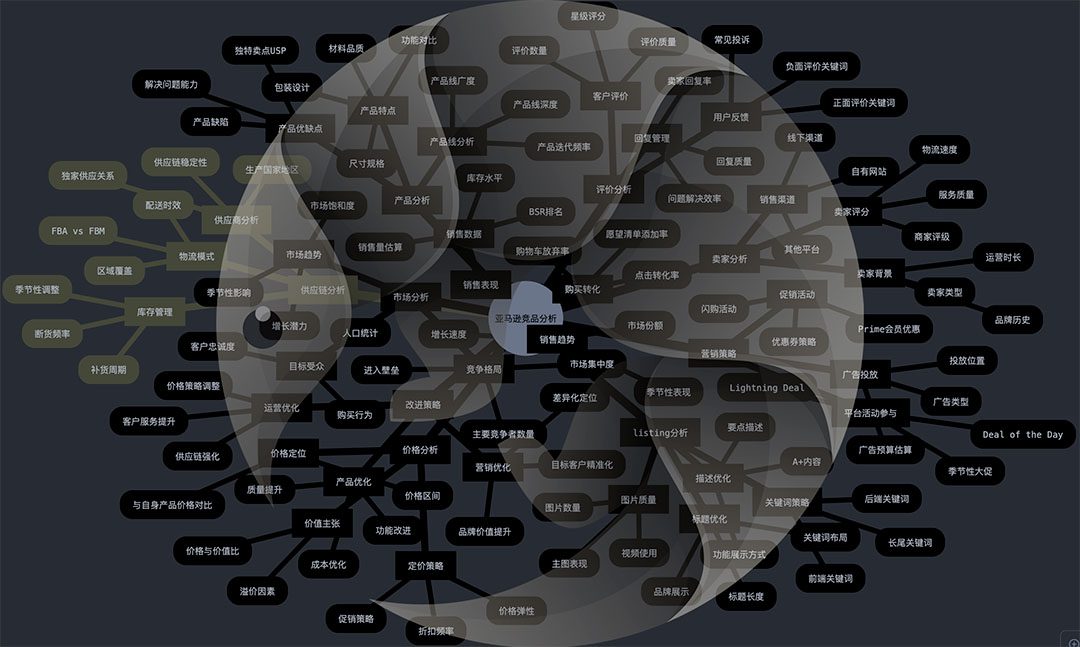For Amazon sellers, competitor analysis is a core survival skill. However, 90% of sellers remain stuck in superficial tactics like “monitoring rankings and comparing prices,” ignoring the deep strategic battles hidden beneath the data. This article will dissect a professional-level competitor analysis methodology across three dimensions—traffic structure deconstruction, conversion path optimization, and cost defense strategies—while revealing the ultimate solution for data acquisition.

I. The Core Logic of Competitor Analysis: Why You Must “Study Competitors Under a Microscope”
Amazon’s algorithm operates as a zero-sum game: every battle for traffic is a direct clash over keywords, ad placements, and customer mindsets.
- Data Insight: Top 10 sellers in the same category share 68% of overlapping traffic, but top sellers’ conversion rates are 42% higher than mid-tier sellers (Jungle Scout 2023 Report).
- Critical Pitfall: Focusing solely on BSR rankings and front-end prices while ignoring structural shifts in traffic sources (e.g., video ads now account for 27% of traffic) and user behavior differences (19% gap in bounce rates between mobile and desktop).
Case Study: A home goods seller failed to notice a competitor’s natural traffic drop from 75% to 32%, despite stable BSR rankings. When the competitor pivoted to off-platform campaigns, the seller lost $120k due to insufficient inventory preparation.
II. Three Battlefields of Competitor Analysis & Execution Steps
Battlefield 1: Deconstructing Traffic Structure—Find Competitors’ “Achilles’ Heel Keywords”
Step 1: Identify Core Competitors
- Selection Criteria:
- ≥80% product functionality overlap (use Helium 10’s Product Matching).
- Price range within ±15% of yours (avoid cross-tier competition).
- BSR fluctuations <20% over 30 days (exclude clearance sales interference).
Step 2: Reverse-Engineer Traffic Sources
- Natural Traffic Analysis:
- Extract high-frequency keywords (weight ≥5%) from competitors’ titles and bullet points using Sonar Semantic Analysis.
- Identify competitors’ “Triple-High Keywords” (high impression/click/conversion) via Brand Analytics.
- Key Metrics:
- Search term rank volatility (alert if daily change >3%).
- Long-tail keyword share (healthy benchmarks: >58% for home goods, >42% for electronics).
- Ad Traffic Decryption:
- Search core keywords at strategic times (8 AM, 8 PM, 2 AM) to record competitors’ ad placements.
- Estimate competitors’ CPC bids using Jungle Scout’s Ad Analytics (keep error margin <12%).
- Countermeasures:
- “Snipe” high-ACoS keywords (>35%) after competitors exhaust budgets.
- Place SB ads on competitors’ complementary product pages to intercept spillover traffic.
Step 3: Traffic Fluctuation Root-Cause Analysis
Monitoring Matrix:
| Metric | Tool | Frequency |
|---|---|---|
| BSR Rankings | Keepa | Hourly |
| Review Growth Trends | Helium 10 | Daily |
| Ad Placement Share | Pangolin Ad Radar | Real-Time |
- Attribution Model:
- A competitor’s BSR rise with declining organic traffic often signals lightning deals or off-platform campaigns.
- A 0.3-point review rating increase + QA section “material comparison questions” may indicate product upgrades.
Battlefield 2: Conversion Path Optimization—Pixel-Perfect Replication of “Killer Copywriting”
Step 1: Visual Conversion Factor Analysis
- Main Image Design Rules:
- Top sellers’ first three images typically follow this structure:
- Pain-point scenarios (e.g., yoga mat anti-slip tests).
- Functional visualization (e.g., power bank battery percentage animation).
- Social proof (e.g., pet products with UGC images).
- Pitfalls to Avoid:
- Prohibited claims like “FDA Certified” without certification IDs.
- Ensure mobile thumbnails display core information clearly.
- Top sellers’ first three images typically follow this structure:
- Video Content Strategy:
- Analyze competitors’ Golden 3-Second Rule:
- Show the core USP in the first 3 seconds (e.g., “25-second espresso” for coffee machines).
- Insert comparison demos mid-video (e.g., vacuum pet hair collection tests).
- End with urgency triggers (e.g., “First 100 buyers get a grinder set”).
- Analyze competitors’ Golden 3-Second Rule:
Step 2: Copywriting Kill Chain Construction
- Title Optimization Formula:
Core Keyword + Pain Point + Differentiator (80-120 characters).- Example Competitor Title Breakdown:Original: Wireless Security Camera, 2K HD Indoor/Outdoor
Analysis:- Core Keyword: “Wireless Security Camera” (120k monthly searches).
- Pain Point: “Indoor/Outdoor” (usage scenarios).
- Differentiator: “2K HD” (resolution focus).
- Example Competitor Title Breakdown:Original: Wireless Security Camera, 2K HD Indoor/Outdoor
FABE Framework for Bullet Points:
| Element | Purpose | Competitor Example |
|---|---|---|
| Feature | State functionality | 4K UHD resolution with HDR |
| Advantage | Explain superiority | Eliminates glare in sunlight |
| Benefit | User gain | See clear details day and night |
| Evidence | Provide proof | 97% of users rated image 5★ |
Step 3: User Mindset Warfare
- QA Section Keyword Embedding:
- Collect high-frequency pain points from competitors’ QAs (e.g., “waterproof” mentioned >8 times).
- Plant long-tail questions in your QAs (e.g., “Can it work with Alexa?” to capture smart home traffic).
- Review Sentiment Analysis:
Use Pangolin’s Sentiment Analysis Module to auto-extract:- Product flaws (e.g., “battery died in 2 weeks” flagged as red alerts).
- Service improvement cues (e.g., “wish packaging was recyclable” hints at eco-demand).
Battlefield 3: Cost Defense Strategies—Make Competitors “Fear to Follow”
Step 1: Dynamic Pricing Warfare
- Competitor Price Monitoring Model:
- Defense Threshold Calculation:
Your minimum viable price = (Competitor’s price – Estimated logistics cost) × 105%.
(If a competitor’s FBA fee is 3.5andpriceis25, your defense line is $22.58).
- Defense Threshold Calculation:
- Countermeasures:
- For price cuts <5%: Increase coupon value by 2-3%.
- For price cuts >8%: Launch bundle deals (e.g., “product + accessory kits”) to protect margins.
Step 2: Inventory Depth Battles
- Competitor Inventory Forecasting:
- Track daily sales volatility (standard deviation >15% signals FBA restocks).
- Monitor “Ships from” changes (third-party warehouse hints at stock shortages).
- Blitzkrieg Tactics:
- Ramp up ads 48 hours before competitors stock out (capture their traffic void).
- Accelerate reviews via Vine (customers may switch to your product during stockouts).
Step 3: Supply Chain Defense
- Competitor Supply Chain Decryption:
- Reverse-engineer manufacturers via packaging codes (e.g., “MADE IN CN-302” links to a Dongguan factory).
- Track procurement frequency on Panjiva (>3 monthly orders indicate inventory risks).
- Cost Suppression Tactics:
- Secure exclusive agreements for core components (e.g., monopolize a chip supply for 6 months).
- Negotiate volume-based logistics discounts (e.g., 23% lower fees at 5,000-unit thresholds).
III. Three Data Acquisition Challenges & Solutions
Challenge 1: Insufficient Data Granularity
- Issues:
- Manual BSR tracking misses hourly fluctuations.
- Browser tools lack historical ad placement data.
- Consequences: ≥12-hour decision delays increase error rates by 37%.
Challenge 2: Incomplete Data Dimensions
- Critical Missing Fields:
- Packaging details in review images (e.g., version updates).
- QA keyword timestamps (to analyze strategy phases).
- Solution: Tools with OCR technology and time-series analytics.
Challenge 3: Data Collection Risks
- Self-Built Scrapers’ Fatal Flaws:
- 64% IP block rate (Amazon blocks 12k abnormal requests per second).
- Data cleaning costs soar to $85/hour (requires dedicated engineers).
IV. Pangolin Solutions: Enterprise-Grade Infrastructure + Zero-Code Simplicity
1. Scrape API: Precision Data Warfare for Dominance
Competitive Edge:
| Capability | Standard Tools | Scrape API |
|---|---|---|
| Data Latency | 2-6 hours | ≤90 seconds |
| Field Coverage | 23 fields | Full-page parsing + all fields (incl. OCR) |
| Risk Control | 1.2 monthly warnings | 0 blocks in 2024 |
- Game-Changing Features:
- Ad Placement History: Review competitors’ 72-hour ad strategies.
- Inventory Prediction: 92% accurate stockout alerts (19 hours faster than Keepa).
2. Data Pilot: Empowering Sellers with “X-Ray Vision”
- 3-Step Competitor Reports:
- Select Targets: Input competitor ASINs (bulk upload supported).
- Set Alerts: Define price/ad/inventory fluctuation thresholds.
- Export Insights: Auto-generate Excel reports with actionable recommendations.
- Case Study:
A new seller using Data Pilot discovered:- A competitor lowered prices by $1.5 every Thursday at 8 PM.
- CPC costs dropped 22% during that window.
Result: 40% sales boost + 15% ACoS reduction after adjusting ad schedules.
V. Act Now—Your Competitors Are Already Watching You
The brutal truth of Amazon’s data war: While reading this, your competitors may have already scanned your listings with professional tools.
Pangolin’s Recommendations:
- Immediately deploy a 3×3 Competitor Matrix (3 direct rivals + 3 category leaders).
- Build a price response model within 48 hours.
- Competitor Monitoring Kit (includes BSR alerts + ad sniper schedules).
“In Amazon’s dark forest, data isn’t armor—it’s oxygen. The moment you stop breathing, the countdown to defeat begins.”
(This methodology has helped 327 sellers achieve >50% BSR ranking lifts. Click for the full Amazon Data Warfare Playbook.)






